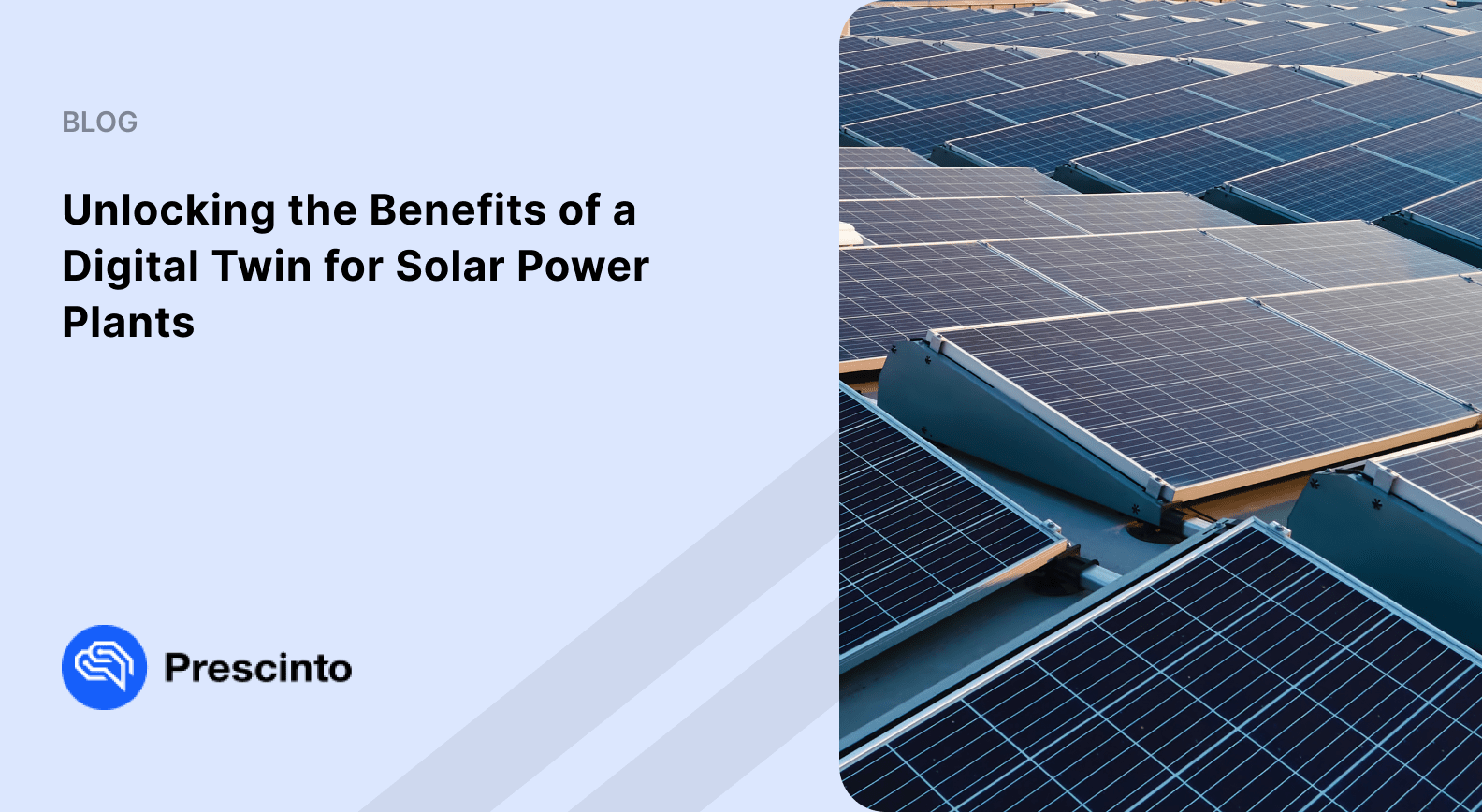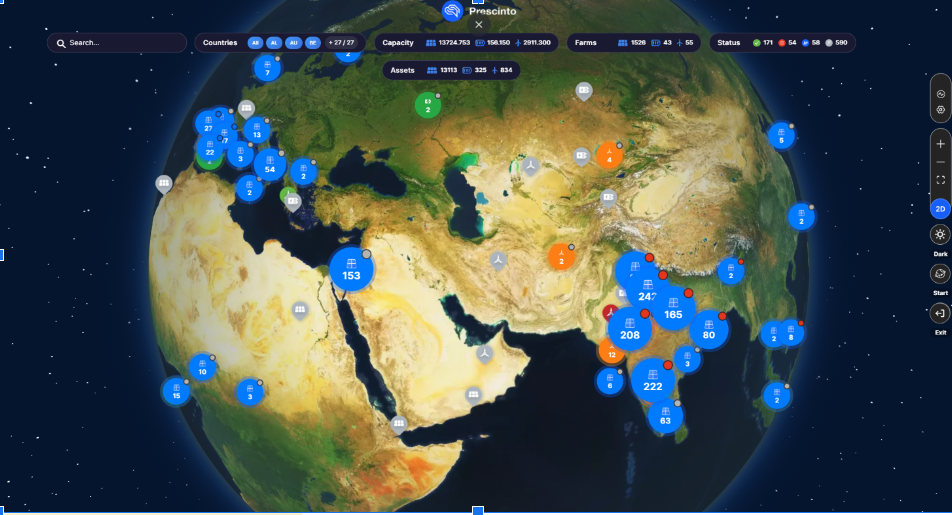Unlocking the Benefits of a Digital Twin for Solar Power Plants

- November 20, 2023
- Prescinto
What are digital twins in solar?
Digital twins are computer simulations that replicate physical solar assets in real time. They allow asset operators to identify potential issues before they have an impact on solar plant performance. By leveraging the digital twin technology, solar power plants can reduce operating costs and improve operational efficiency.
Let’s explore the basics of digital twin technology and identify the benefits it offers for solar power plants. We’ll also examine the challenges associated with implementation and understand the best practices for successful deployment.
Leveraging the potential of digital twins offers the key to unlocking the full potential of solar power plant operations.
Understanding the basics of digital twin technology
The global solar PV installation growth is projected to rise by 56% in 2023, according to Bloomberg New Energy Finance, and digital twins are quickly becoming an integral part of the future of solar power plant operations. By creating a digital replica of physical assets, systems, and processes, it is possible to gain valuable insights into how operations can be improved.
A digital twin is a virtual representation of the actual solar asset. It takes on the appearance, functionality, and integration of a solar plant, aiming to enhance and optimize decision-making across various timeframes. The twin should be customized based on key factors such as the solar power plant’s geographical location, local power and weather data, and power loss factors.
A well-designed digital twin, once established, consolidates plant data and inputs it into AI/ML algorithms. These algorithms are responsible for processing, conceptualizing, and modeling the real-world behaviors of the plant. Additionally, the continuous stream of data from IoT sensors from the plant ensures that the algorithm constantly learns and evolves into a self-adaptive intelligent system. The virtual model uses real-time data to monitor asset performance and provide actionable information for operators. Consequently, it helps reduce operational costs by optimizing the usage of resources, as well as ensuring that all components remain in good working condition throughout production cycles.
In addition to providing cost savings, digital twin technology can also be used for predictive maintenance purposes. Through continuous monitoring of system variables such as active power and current in solar plants, potential issues can be identified before they have an impact on performance – helping reduce downtime significantly while increasing overall safety at the plant.
Furthermore, digital twins allow operators to simulate different scenarios to determine which one will bring them closer to their desired outcome faster. This allows for informed decisions based on their current situation and goals for the future – giving them a competitive edge in today’s market.
Exploring the benefits of a digital twin for solar power plants
Digital twins are no less than a revolution in the way solar power plants are managed. These digital replicas of physical assets provide operators with an unparalleled level of control and understanding of their renewable energy production. Deploying digital twins for solar power plants has numerous advantages that result in increased efficiency and cost savings over time.
Unparalleled predictive insights
Digital twins are, at their core, predictive powerhouses. They possess the remarkable ability to detect the subtlest fluctuations in energy generation patterns. This means that even the smallest signs of underperformance in assets are quickly identified. Armed with real-time data, engineers can fine-tune parameters and make precise adjustments, resulting in a significant boost in efficiency and a substantial reduction in downtime.
Remote monitoring for performance and operational efficiency
One of the standout features of digital twins is the portfolio-level real-time monitoring of solar assets across the globe. For instance, managing multiple solar assets in remote locations by deploying resources is an inefficient and cost-heavy task at hand for asset owners. But with the help of digital twins, they can monitor the performance of their plants spread across the world in real time and take necessary maintenance actions as and when required.
Including corrective maintenance in the scope of service reduces the exposure to high-priced, dispatched services and provides additional benefits of dedicated plant personnel. This strategy decreases the overall cost of O&M for asset owners by up to 28% or more and enhances the service model stability of O&M providers, thus reducing the overall cost of O&M, according to the Solar Risk Assessment Report. Ultimately, this can boost equity returns by 10%, with typical ROIs for solar assets ranging around 10-15%.
Cost efficiency and visibility
O&M professionals are adopting digital twin technology to achieve an impeccable 70% reduction of cumbersome manual activities, as per PV-Tech. Moreover, digital twin technology brings unparalleled visibility into operational costs and processes. This newfound transparency not only leads to significant cost savings but also propels progress toward sustainability objectives. Whether it’s minimizing energy waste or improving customer satisfaction scores, digital twins play a pivotal role. This synergy of data-driven insights takes decision-making to a whole new level, elevating productivity across all facets of solar power plant operations.
Identifying the challenges in implementing digital twins for solar power plants
Deploying digital twin technology for solar power plants may seem like an ideal solution to improve efficiency and reduce operational costs, but it’s not without its challenges.
1. Data dependency
The effectiveness of a digital twin hinges on the quality and timeliness of the data it relies on. Renewable and solar plants, which are often in remote and tough locations, can encounter data quality problems due to equipment wear and tear from harsh conditions. These problems include incorrect readings, unusual data points, sudden spikes, missing data, and unreliable values. These issues can have varying effects on plant performance and calculations, making it tricky to have a one-size-fits-all solution for data quality management among renewable asset owners.
In addition to the obvious problems, subtle and gradual data changes over time can be hard to spot, emphasizing the need for a thorough approach to data quality in renewable energy operations. Accessing real-time data from diverse sources like sensors, controllers, and meters is paramount for digital twins. Any discrepancies or delays in data can hamper the ability to provide meaningful insights.
2. Integration complexities
Key components, such as panels, inverters, meters, relays, and transformers, play a vital role in the seamless operation of a solar PV system. However, this equipment produces data in various formats and frequencies. The data may be scattered across different locations and time zones, leading to time-series inconsistencies that result in data inaccuracies, errors, and security concerns. Furthermore, this diversity introduces data quality issues, including junk values, outliers, false positives, and more.
Additionally, the granularity and frequency of data generation, ranging from 1-minute to 60-minute intervals, pose challenges when it comes to data integration and creating a cohesive dataset. Solar power plants often have intricate and varied legacy systems that need seamless integration into the digital twin platform. This integration process can be intricate and costly if not executed with precision. For instance, in case, the inverters are not communicating at the same frequency, it can be difficult to monitor those components and compute KPIs accurately.
3. Security and privacy concerns
Protecting data integrity and privacy is a paramount concern when deploying digital twin systems. A breach in data security can not only lead to financial repercussions but also tarnish the reputation of the plant.
4. Implementation and maintenance costs
Implementing a digital twin system can entail substantial upfront costs, including infrastructure setup. Ongoing expenses for updates and support services further add to the financial challenge. Additionally, solar asset owners need to budget for support services to address technical issues, ensure system reliability, and continuously improve the digital twin’s performance. Effectively managing these costs is essential, as a well-maintained digital twin can contribute significantly to enhancing solar plant efficiency, minimizing downtime, and optimizing energy generation, ultimately justifying the initial investment.
5. Expertise shortage
The management of digital twins requires a specialized skill set. A lack of expertise can result in inefficient deployments and the underutilization of resources. This, in turn, can lead to missed optimization opportunities and hinder overall performance.
Best practices for deploying a digital twin for solar power plants
Deploying a digital twin for solar power plants can be quite complex, but with the right strategy in place, it can lead to remarkable results. To make sure this project is successful, asset owners, operators, and managers should identify their objectives and goals before beginning implementation and develop data strategies to ensure the accuracy of information.
Additionally, leveraging analytics tools gives organizations insights from the data that can help them improve operations or adjust processes accordingly. Furthermore, integrating alerts and notifications allows teams to address issues quickly before they become too costly or time-consuming.
Finally, it is important to test and evaluate plans throughout the development and deployment stages; this ensures that everything runs smoothly during implementation as well as after launch while providing feedback on how well certain features are performing in terms of meeting objectives set out at the start of the development stage. By following these best practices when deploying a digital twin for solar power plants, asset owners, operators, and managers will be able to optimize their asset performance, reduce operational costs, and increase efficiency.
Is a digital twin right for your solar power plant?
As the solar power industry strives to reduce expenses and improve asset performance, a digital twin is becoming an attractive approach for solar power plants. This technology is capable of optimizing operations and cutting down maintenance costs. Nevertheless, it may be difficult to understand if a digital twin solution is suitable for each scenario due to the challenges associated with its implementation.
Therefore, solar plant operators and managers should take into account any potential difficulties that might occur during the deployment process. Moreover, assessing all aspects of a digital twin’s cost-benefit analysis can help determine whether or not it is worth the investment in the long run. In addition, companies must evaluate their goals and objectives before making an informed decision about whether or not to use a digital twin for their solar power plant.
Data management strategies, along with integration with existing systems, need to be developed to guarantee accurate information throughout the development and deployment stages of this technology. Analytics tools should also be leveraged as well as training programs and testing and evaluation plans implemented to make sure that everything goes smoothly when operating a digital twin for your solar power plant.
By carefully evaluating each factor mentioned above when deciding whether or not a digital twin is appropriate for your solar power plant, businesses can maximize its benefits while avoiding costly errors at the same time.
Why Prescinto is critical for digital twin capability at solar energy assets
Prescinto is a powerful platform powered by advanced technologies, such as artificial intelligence (AI), machine learning (ML), and advanced data analytics. The platform allows solar asset owners, solar asset managers, OEMs, and O&M providers to monitor, analyze, and operate their assets effectively. Prescinto leverages an AI-driven loss categorization algorithm to pinpoint and separate diverse losses within solar plants. The platform uses regression-based digital twin creation to ensure precise identification of performance-affecting areas.
As the demand for renewable energy continues to soar, digital twin technology has emerged as a game-changer for the solar energy sector. Digital twins play a pivotal role in monitoring, analyzing, and optimizing solar power plant operations. However, not all digital twin solutions are created equal, and this is where Prescinto comes into play.
High-quality data
Prescinto’s data governance module, Baikal, provides a comprehensive assessment of data quality and availability at individual plants. It conducts a thorough analysis of raw time-series data, identifying irregularities such as outliers or missing data. These issues are categorized into two main groups: data availability and data quality.
Data availability is evaluated by examining the percentage of missing data (blank or N/A), while data quality focuses on identifying data that falls outside acceptable thresholds, including erroneous and zero/constant values. This guarantees that there are no discrepancies or data delays that could hinder the digital twin’s capacity to deliver valuable insights.
Digital twin and analytics
The Al-based data analytics tool developed by Prescinto is specifically designed to help solar power plants identify the underperformance caused by various systemic issues such as soiling, clipping, curtailment, and other losses. It utilizes a cutting-edge, patent-pending machine learning algorithm that is tailored specifically for the analytics of solar power plants.
The algorithm analyzes the data on the digital platform at all device levels on the solar power plant. These digital twins replicate the physical devices, such as inverters, transformers, and strings, in real-time. This digital replication is a crucial aspect of digital twin technology because it enables operators to closely monitor and assess the performance of each component.
For instance, during peak sunshine hours, when the DC array surpasses the inverter’s AC capacity, the inverter limits energy input to match its rated AC capacity. This causes clipping loss. Prescinto recognizes curtailment events and computes this loss by comparing the inverter’s actual generation with its digital twin. This loss is partially recoverable, which means that asset owners, asset managers, or OEMs can course-correct immediately to reduce this loss.
Precision in detention
Prescinto’s AI-powered loss bucketing tool goes above and beyond by detecting even minor variations in the generation pattern, as small as 1-2%. These tiny discrepancies might go unnoticed with conventional digital twin systems, but Prescinto’s technology identifies them promptly. This precision is a game-changer, as it enables plant operators to address underperforming assets swiftly. For example, Prescinto’s pattern recognition algorithm identifies shadow-related events, calculating losses by comparing inverters’ actual generation with its digital twin. This is partially recoverable, depending on the shadow’s cause.
Real-time analysis
One of the key advantages of Prescinto’s solution is its ability to analyze the digital twins of inverters in real time. This means that plant operators can access up-to-the-minute data, allowing them to identify and address issues as they happen. Real-time analysis is crucial for improving the overall performance of a solar power plant, as it minimizes downtime and maximizes energy
- Topics: Solar
About Author





